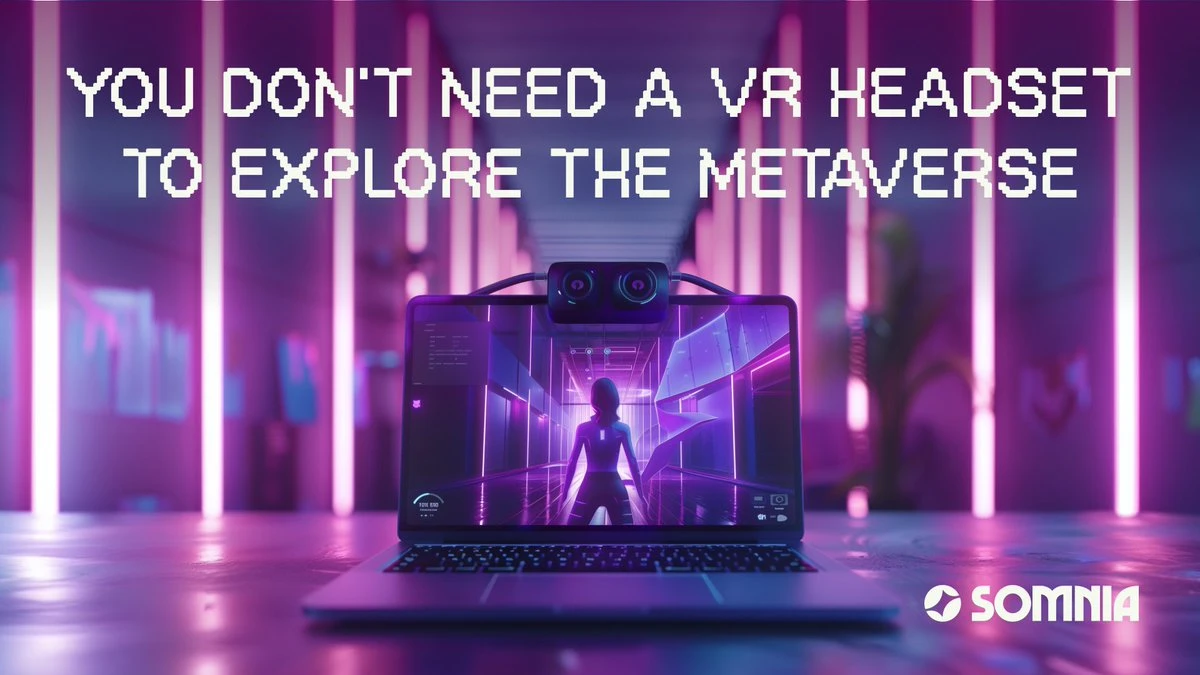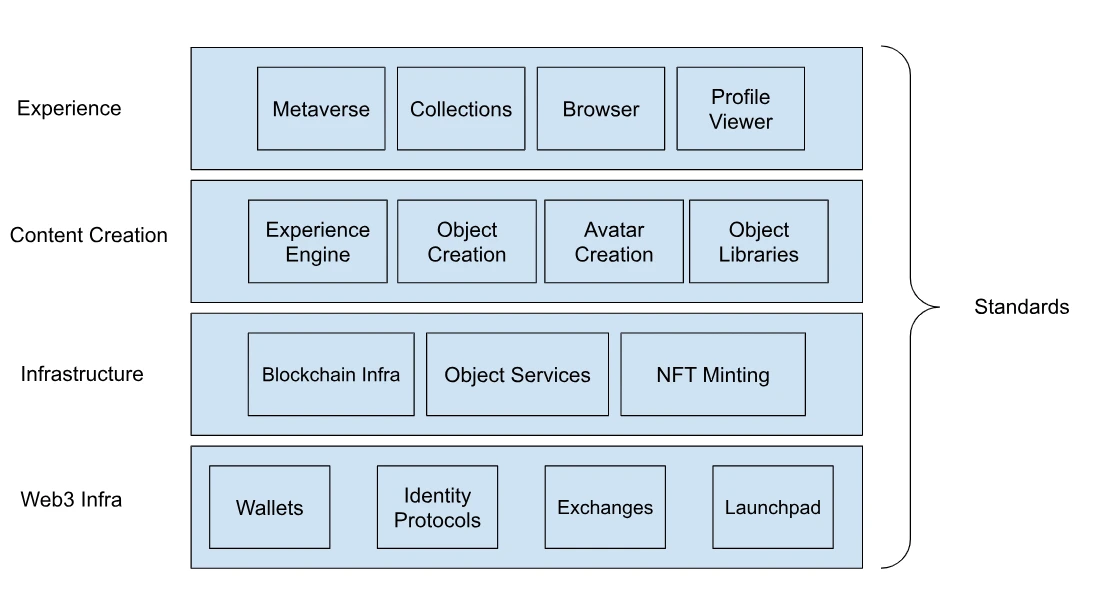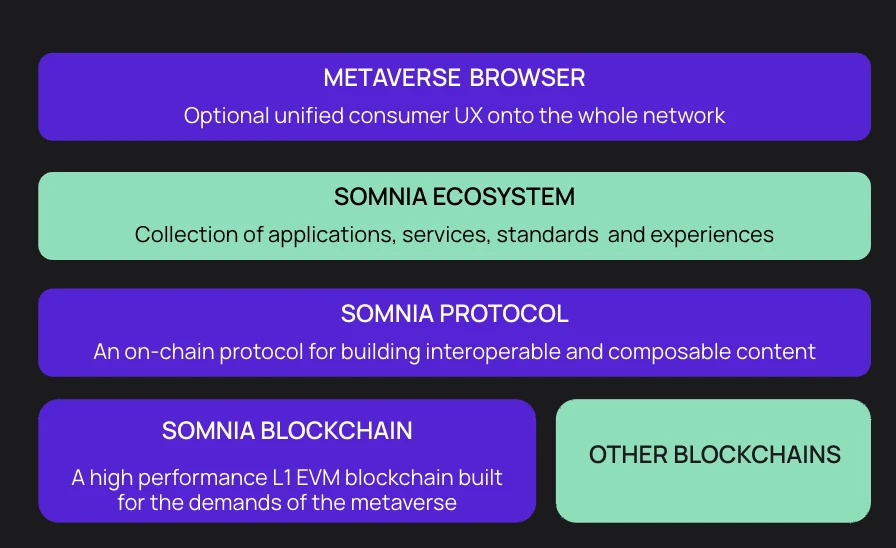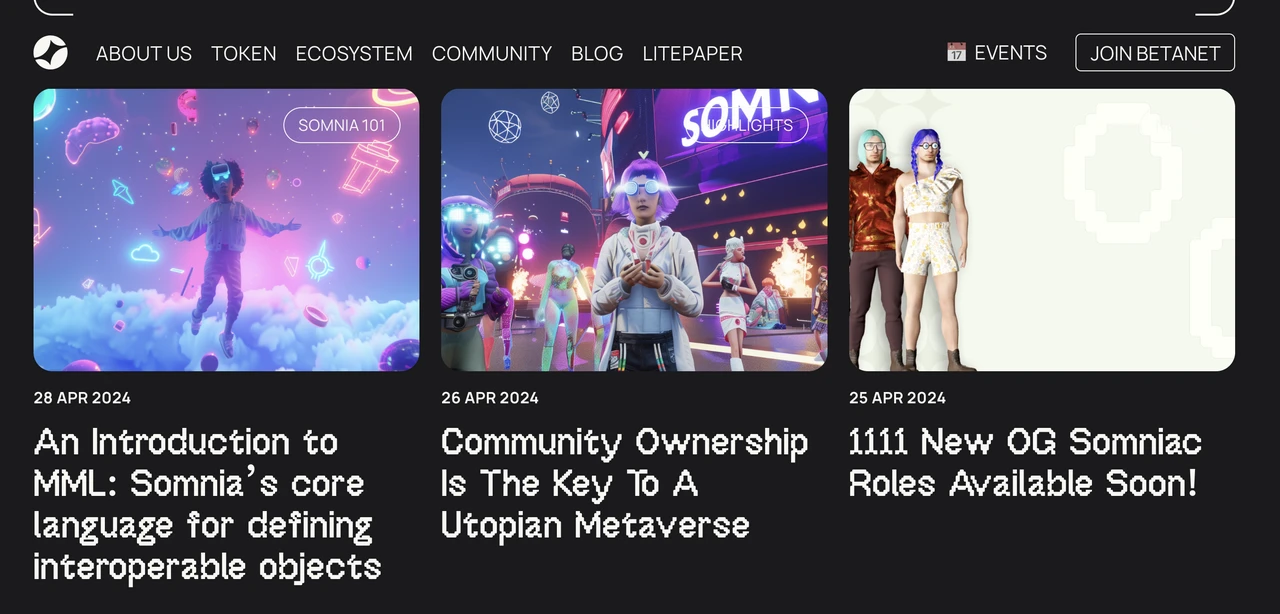Original | Odaily Planet Daily
Author | Wenser

As we enter 2024, the development of AI is in full swing, and with it comes the significant impact of AIGC (Artificial Intelligence Generated Content) on the creator economy. While metaverse giants such as Roblox and Meta are shifting their focus to other areas, creators, as the core producers of the information world, urgently need new "solutions" to ensure that their painstakingly created content receives its due rewards.
In response to the current dilemmas facing the creator economy and the longstanding content challenges of blockchain information networks, Somnia, with its core ecosystem of "L1 public chain + full-chain protocol + metaverse browser," is expected to become the "breaker of the post-metaverse era" that carries the creator economy.
I. In the post-metaverse era, where is the way out for the creator economy?
In 2021, the metaverse boom led by companies such as Roblox and Meta, with "multiplayer online interaction and social entertainment" as the main scenes, was all the rage. However, three years later, Roblox's market value has dropped by nearly 50% from its peak, and its annual losses continue to expand. The emergence of LLama3 also marks a phase in which Meta's business focus shifts to the AI track. As the "pre-metaverse era" gradually comes to an end, the need to build a post-metaverse era that solves the dilemmas of creators and information content becomes increasingly urgent.
Looking back, the current metaverse and creator economy are mainly facing the following specific problems:
1. Challenge of economic return rate
Due to the early-stage preparation and long-term planning of projects, the development cycle and cost of metaverse projects are often an unavoidable issue. Especially since many metaverse projects mainly draw on the ideas of traditional games and social platforms, they often fall into a dilemma between cost input and economic return, leading to project stillbirth or even death.
2. Centralized platform control
Excessive centralization is another urgent problem to be solved. Just as many social media platforms monetize the value of content created by creators through advertising, many participants and creators are unable to receive their due rewards, undermining their enthusiasm for innovation and creation. Many past cases have also verified that metaverse projects controlled by centralized platforms often run counter to the spirit of a free and open metaverse.
3. Immaturity of Web3 metaverse projects
Although Web3 metaverse projects are emerging in large numbers, due to limitations such as insufficient blockchain network performance, lack of clear universal standards, and insufficient independent scalability, it is still difficult in the short term to achieve the decentralized, co-built, and shared ecosystem with clear rules promised by some projects. Therefore, they are still immature in practical implementation.
4. Difficulty in establishing a closed-loop creator economy
Previous metaverse projects have paid little attention to the online experience of creators and users. Firstly, there are no clear creative guidelines and a clear incentive system plan. Secondly, creators and users are often mixed together without clear role stratification. Thirdly, it is difficult to establish a flexible and effective closed-loop production and consumption relationship between "consumers-content products-creators."
As a result, the existing metaverse projects are highly homogenized and have the following defects:
(1) They cannot provide users and creators with a high-quality online metaverse world experience;
(2) They cannot integrate the online world and economic system into an interconnected metaverse world;
(3) They cannot establish a metaverse ecosystem that empowers users and creators while possessing long-term investment value.

Somnia official website interface
II. Providing a larger stage for dreamers
In response to the various problems mentioned above, different from the operational system of many previous metaverse projects, Somnia is committed to creating a new type of metaverse virtual society that serves the creator economy, positioned in the L1 public chain ecosystem. The solution is divided into four levels, mainly including:
1. Improving blockchain network performance
From first principles, a metaverse that can carry the creator economy inevitably requires revolutionary breakthroughs and changes at the foundational infrastructure level. Based on the operational logic of on-chain creation, on-chain transactions, on-chain consumption, and on-chain circulation, a blockchain network that can handle a larger magnitude of operations, accommodate more users, and serve different individual users is indispensable.
2. Creating universal rule protocols
An open and free metaverse requires a series of universal rule protocols as the underlying architecture to help people, events, and objects in the metaverse space understand each other and interact efficiently, making it highly interoperable and composable, and continuously expanding and enriching this virtual society.
3. Defining spatial object standards
On the basis of the underlying universal protocols, specific standards for diverse objects such as application ecosystems, specific content, and spatial products should be established. Just as designers need to determine specific design requirements and produce the final design product through different color codes and tones, clear object standards help accelerate the construction of the metaverse, avoid conflicts and hidden dangers caused by inconsistent internal rules.
4. Establishing an efficient incentive system
The establishment of a metaverse virtual society is a long-term endeavor, requiring more people to participate in its construction. Therefore, it is imperative to encourage sharing and ensure the incentive system for participants in the corresponding value return ecosystem, in order to gradually generate network effects, attract more creators, consumers, and brands, products, and platforms from different fields to become part of this decentralized network.
Combined with Somnia's current advantage of being able to enter the metaverse world experience without the need for VR headsets, a metaverse virtual society composed of rich scene experiences, interconnected metaverse block networks, and an empowering and growing economic system becomes possible. At that time, participants in the Somnia metaverse will be able to establish a truly commercial system without resorting to the old path of relying solely on the survival of a large-scale gaming business.

Source: Somnia official account
To some extent, with the support of Web3 underlying systems (including wallets, identity protocols, trading platforms, launchpads), infrastructure construction (including blockchain basic networks, object services, NFT minting applications), content creation (experience engines, object creation, avatar creation, object archives), and scene experiences (metaverse space, NFT collections, metaverse browsers, personal profile viewers) and other layered products, Somnia has established many ecological and industry operation standards, and through a "modular thinking + layered structure," it has further compressed the development cost and the risk of an economic system with high composability, transforming a traditional "centralized platform-type business" into a new "decentralized network architecture," providing a "new solution to the dilemma of the post-metaverse era."

Somnia's four-layer architecture system composition of ecological and industry standards
III. Virtual society practice with resource and technology support
And the reason Somnia is able to take a new path "different from previous metaverse projects" is mainly due to its ample technical reserves and strong resource support.
It is understood that Somnia was founded by the Virtual Society Foundation (VSF), which is supported by the UK startup company Improbable and its subsidiary MSquared. As a star technology company that created the well-known computing platform SpatialOS, Improbable received a $150 million investment in 2022 from a number of well-known investment institutions such as a16z, SoftBank, Mirana Ventures, CMT Digital, and SIG. It is worth mentioning that many NFT players may be familiar with the company, as Yuga Labs collaborated with it to develop the metaverse project Otherside, which successfully tested interactions of over 15,000 players in a virtual space. Somnia is a strong complement to the vision of the open and community-owned metaverse previously established by Improbable and MSquared, and has made significant contributions in terms of technology.
The technical elements that Somnia is currently building mainly include:
The Somnia Blockchain: This is a high-performance L1 blockchain network built to operate at high performance and low cost for the metaverse, and is compatible with the EVM network.
Somnia Protocol: A protocol for defining the logic of all people, places, and objects in the blockchain network, which will help achieve interoperability and compatibility throughout the entire metaverse world, and to some extent increase its scalability and flexibility.
Somnia Ecosystem: A collection of various applications, services, rules, and experiences built on the blockchain network and protocol.
Metaverse Browser: A web front-end interface for interacting with all products on the Somnia network and applications (similar to the relationship between the social protocol Farcaster and the application client Warpcast).
Specifically, in terms of achieving large-scale transaction data throughput, the Somnia blockchain has made the following optimization improvements:
Independent Data Chains: Each validator can run their own blockchain or "data chain," allowing for independent block production. This method eliminates the need to establish a consensus mechanism in a single data chain, simplifying the data processing workflow.
Consensus Chain: A single blockchain aggregates the head operations of all data chains, using a modified Hotstuff algorithm for proof-of-stake consensus. This structure separates data production from the consensus process, greatly improving overall efficiency.
Compiled Bytecode: By converting EVM bytecode into highly optimized native code, Somnia achieves execution speeds close to hand-written C++ contracts, making it possible to execute millions of transactions per second on a single core.
Advanced Compression Technology: The Somnia data chain architecture combines it with BLS signature aggregation to achieve extremely high compression ratios, enabling streaming compression effects and achieving massive transaction data throughput, theoretically outperforming other blockchain networks' "bandwidth limitations."
State Optimization Management: Somnia has abandoned the traditional full-state Merkle tree in favor of two smaller, cache-friendly Merkle trees, speeding up state updates by balancing different lightweight clients.
With the support of the above resources and technical reserves, Somnia is expected to build a metaverse world as follows:
First, in terms of interconnected ecological networks, Somnia can help commercial entities such as creators, IP rights holders, and brands achieve cross-platform transfer of assets, business, and digital identities through standardized infrastructure, including Metaverse Markup Language (MML) and the MSquared Origin Engine, promoting the diverse combination of digital content.
Second, in the co-creation and sharing of content creation, creators can innovate and reproduce existing works. Whether it's metaverse event components (such as concerts, light shows, fireworks displays, and related props) or digital identities, products, and information (such as avatars, metaverse images, metaverse accessories, and metaverse social media materials), original creators can earn royalties through microtransactions, while secondary creators can earn corresponding sales revenue, and consumers can enjoy unique scene experiences, achieving a win-win situation for all parties.
Third, in the realm of real interactive scene carriers, upgradable NFTs can give soul to existing 2D NFT images, allowing them to roam freely as 3D objects in the metaverse. Somnia can provide free upgrades for specific NFT projects to meet the display, performance, and identity verification needs of NFT holders. Furthermore, the construction of a metaverse world based on different NFT themes will become possible.
Finally, in the encouragement of innovative creator economy models, Somnia places great emphasis on decentralized economic structures and the contributions of high-quality creators, using community-driven governance to ensure that the actual innovators receive the value they deserve, further encouraging the development of innovative use cases.

Components of the Somnia metaverse world
IV. Diversified expansion of content consumption scenarios
Of course, resources, funds, and technological applications are just the beginning. The emergence of the creator economy metaverse naturally cannot do without diverse content consumption scenarios. After all, as the saying goes, "No experience, no consumption"—novel experiences composed of different high-quality content are the best reason to attract more users, creators, and commercial entities to join, as this can generate hot topics, eye-catching marketing events, and unforgettable large-scale activities.
The past accumulation of MSquared will lay a solid foundation for this part, including the creation of an official virtual metaverse baseball stadium in collaboration with Major League Baseball (MLB), virtual space music parties (Kosmopop) held in collaboration with Universal Music and the Korean pop group TWICE, the Web3 game metaverse Project Edison created in collaboration with the Web3 industry celebrity BoardElonMusk, and the football-focused metaverse virtual stadium Victory League, as well as other various types of collaborations covering sports, entertainment, and fan economy, among other fields.
In these scenarios, users can purchase digital collectibles, enjoy online competitions, listen to the latest albums, participate in competitive games, and interact with celebrity figures digitally, greatly expanding audiovisual experiences, enriching interactive forms, and broadening the dissemination of information. In the current context of the increasing average online time per person globally, the increasingly diverse consumption of digital content is gradually becoming mainstream, and this is also the direction in which Somnia is gradually expanding and striving to achieve.
It is reported that Somnia has now entered the Beta testing network phase, allowing early community members (referred to as Somniacs, which can be understood as dreamers or dream chasers) to experience immersive digital spaces and try interoperable NFT avatars and large-scale online gatherings in the Somnia ecosystem.

Somnia official Blog interface
V. Looking forward to Somnia's dream journey
As the main force behind Somnia, Improbable, founded in 2012, has been working in the field of large-scale simulated virtual world construction for 12 years. Somnia represents the latest and highest expectations of this technology unicorn.
Different from previous small-scale projects, overall, Somnia is an open world that integrates elements such as "creator economy, composable content, upgradable NFTs, and multi-platform ecosystem." It is also a comprehensive ecosystem positioned on the L1 public chain and full-chain protocol, involving various tools and underlying infrastructure spanning the Web2 and Web3 domains, such as the MSquared Origin platform (based on the Unreal Engine, for high-performance experiential basic applications), open web engine, self-hosted servers running Unreal or Unity, MML Editor, Meshy.ai, Avatrun, Ready Player Me, MSquared avatar generator, IPFS, Arweave, EIP-4337 account abstraction standard, AMM, CLOB, and many others.
In the near future, when the Somnia Beta testing network ends and the mainnet goes live, combined with past business resources, Somnia is expected to spark a new wave of attention and enthusiasm in the metaverse field and related industries such as gaming, competitions, sports, entertainment, and fashion.
At that time, a virtual dream woven by many dreamers will unfold before more people, and let us look forward to it together.
免责声明:本文章仅代表作者个人观点,不代表本平台的立场和观点。本文章仅供信息分享,不构成对任何人的任何投资建议。用户与作者之间的任何争议,与本平台无关。如网页中刊载的文章或图片涉及侵权,请提供相关的权利证明和身份证明发送邮件到support@aicoin.com,本平台相关工作人员将会进行核查。




